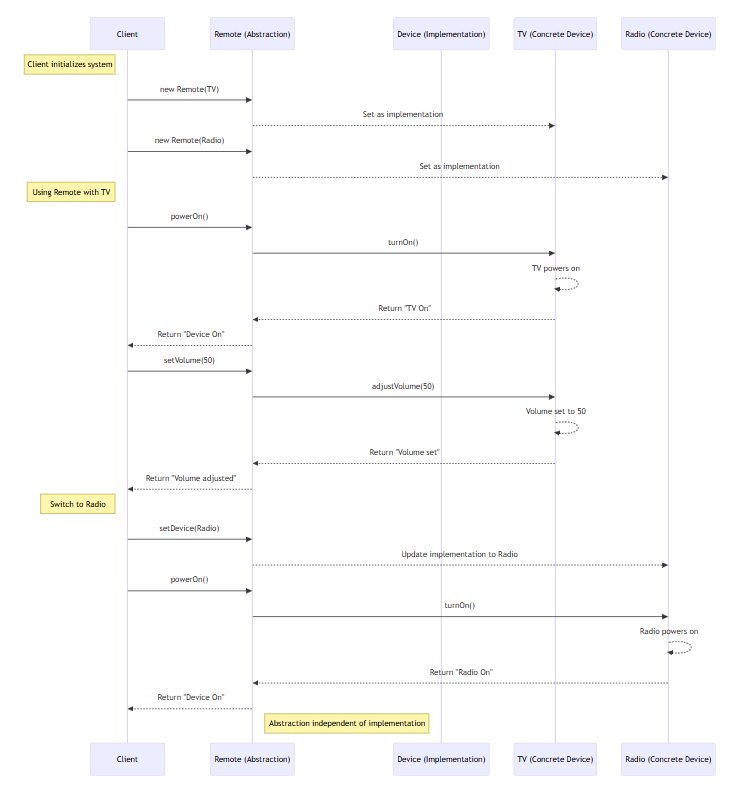Bridge Design Pattern

Table of Contents
- Introduction
- Understanding the Bridge Pattern
- Benefits and Use Cases
- Implementation Example
- Best Practices
- Common Pitfalls
- Performance Considerations
- Conclusion
Introduction
The Bridge pattern stands as a fundamental structural design pattern in software engineering, offering an elegant solution for decoupling abstractions from their implementations. This comprehensive guide will walk you through its implementation, use cases, and best practices.
Understanding the Bridge Pattern
The Bridge pattern represents a powerful architectural approach that divides complex class hierarchies into two parts:
- Abstraction
- Implementation
This separation allows both aspects to evolve independently, providing greater flexibility in system design.
Benefits and Use Cases
Key Advantages
-
Decoupled Architecture
- Separates interface from implementation
- Enables independent development
- Reduces system complexity
-
Enhanced Flexibility
- Supports runtime implementation switching
- Facilitates platform independence
- Enables easy system extensions
-
Improved Maintainability
- Simplifies code organization
- Reduces class explosion
- Facilitates testing
Implementation Example
Here's a practical implementation of the Bridge pattern in Java:
// Implementor interface
interface DrawAPI {
void drawCircle(int x, int y, int radius);
void drawSquare(int x, int y, int side);
}
// Concrete Implementors
class RedRenderer implements DrawAPI {
public void drawCircle(int x, int y, int radius) {
System.out.println("Drawing Circle in red at (" + x + "," + y + ")");
}
public void drawSquare(int x, int y, int side) {
System.out.println("Drawing Square in red at (" + x + "," + y + ")");
}
}
class BlueRenderer implements DrawAPI {
public void drawCircle(int x, int y, int radius) {
System.out.println("Drawing Circle in blue at (" + x + "," + y + ")");
}
public void drawSquare(int x, int y, int side) {
System.out.println("Drawing Square in blue at (" + x + "," + y + ")");
}
}
// Abstraction
abstract class Shape {
protected DrawAPI drawAPI;
protected Shape(DrawAPI drawAPI) {
this.drawAPI = drawAPI;
}
abstract public void draw();
}
// Refined Abstractions
class Circle extends Shape {
private int x, y, radius;
public Circle(int x, int y, int radius, DrawAPI drawAPI) {
super(drawAPI);
this.x = x;
this.y = y;
this.radius = radius;
}
public void draw() {
drawAPI.drawCircle(x, y, radius);
}
}
class Square extends Shape {
private int x, y, side;
public Square(int x, int y, int side, DrawAPI drawAPI) {
super(drawAPI);
this.x = x;
this.y = y;
this.side = side;
}
public void draw() {
drawAPI.drawSquare(x, y, side);
}
}
Implementation Guidelines
1. Component Identification
When implementing the Bridge pattern, identify these key components:
- Abstraction: Define core interface
- RefinedAbstraction: Extend base abstraction
- Implementor: Create implementation interface
- ConcreteImplementor: Implement specific functionality
2. Design Considerations
For successful implementation:
- Keep interfaces focused and minimal
- Plan for future extensions
- Document relationships clearly
- Consider using factory patterns
Best Practices
-
Clear Separation
- Maintain distinct boundaries
- Avoid cross-hierarchy dependencies
- Keep responsibilities separate
-
Interface Design
- Follow interface segregation
- Design cohesive interfaces
- Consider future extensions
-
Testing Strategy
- Test hierarchies independently
- Verify interface contracts
- Ensure proper integration
Common Pitfalls
Avoid These Common Mistakes
-
Over-engineering
- Don't use Bridge for simple hierarchies
- Avoid unnecessary complexity
- Consider simpler alternatives
-
Poor Abstraction
- Don't create tight coupling
- Avoid concrete dependencies
- Maintain proper separation
Performance Considerations
Understanding Performance Implications
-
Overhead Assessment
- Minor indirection cost
- Negligible in modern systems
- Benefits outweigh impact
-
Optimization Opportunities
- Cache implementation instances
- Minimize object creation
- Use efficient interfaces
Key Takeaways
- Use Bridge pattern for complex hierarchies
- Maintain clear separation of concerns
- Focus on interface design
- Consider performance implications
- Document relationships clearly
Conclusion
The Bridge pattern offers a robust solution for managing complex system architectures. By separating abstractions from implementations, it provides flexibility and maintainability that modern software systems require.